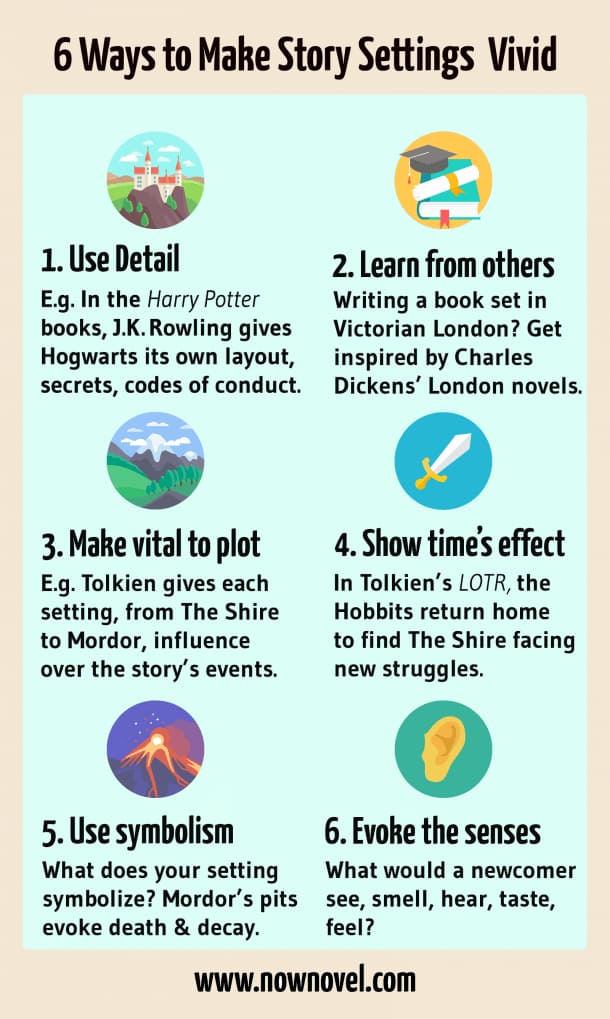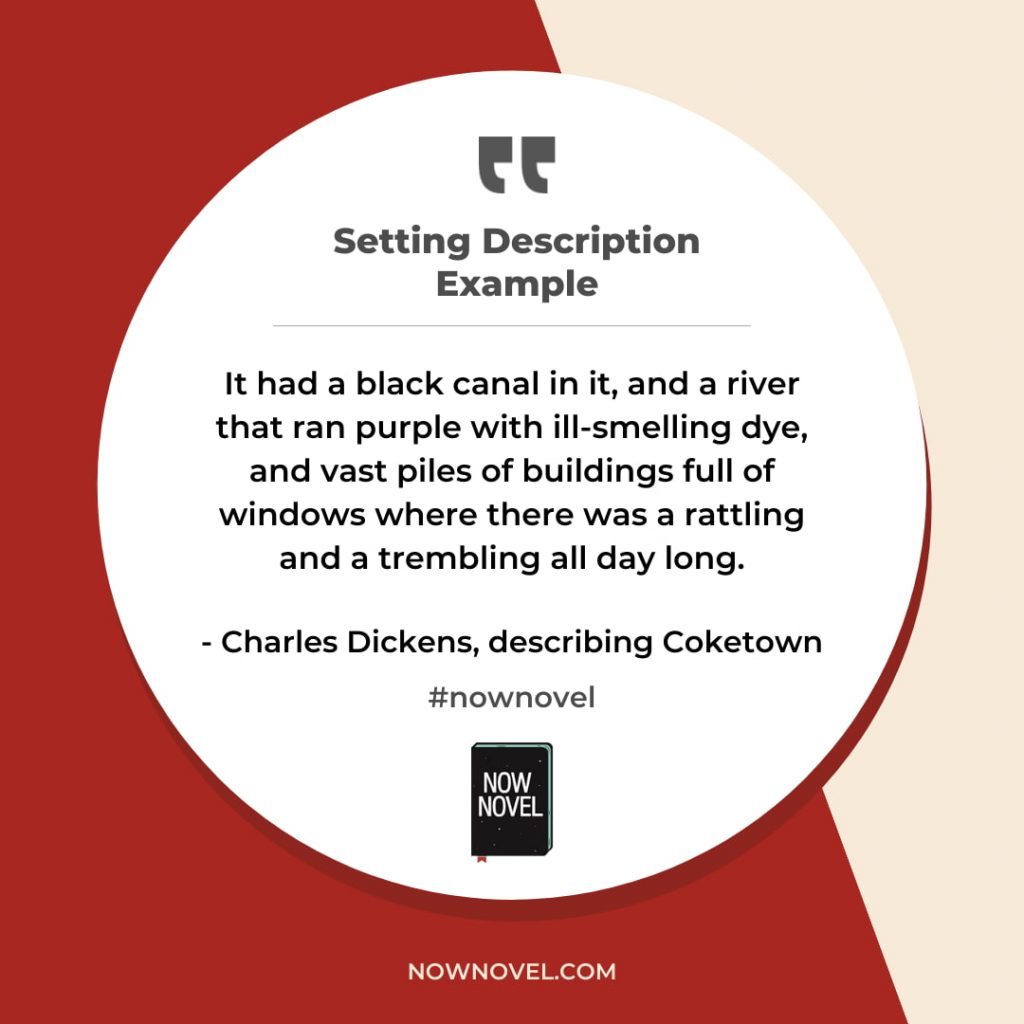The best book setting ideas are highly effective.
Setting is a literary device where a writer establishes a time frame, location and the environment of a story.
In a novel where the author performs careful worldbuilding, the story setting enriches plot events with atmosphere and mood; context and contrast. Here are 6 story setting examples and tips we can gather from reading them:
1. Give your story setting detail
A magical ‘elsewhere’ is one of the key ingredients of many fantasy novels, particularly in portal fantasies where characters travel between our ordinary world and a world of magical landscapes and creatures.
One of the reasons why children (and adults) around the world fell in love with J.K. Rowling’s Harry Potter series is the depth and intricacy of Rowling’s settings. Rowling’s world is one of stark contrasts, from Harry’s aunt and uncle’s ordinary and oppressive suburban home to the towering spires of the series’ school of magic, Hogwarts.
Like Rowling, give your setting detail when writing a novel.
Hogwarts School of Witchcraft and Wizardry is a character in itself. Portraits of prior staff hanging in corridors are animated and talk. Stairways move by enchantment. Even the ceiling design of the school’s dining hall changes according to school events and seasons.
Further, Rowling is smart because she gradually reveals details of Hogwarts’ many additional rooms and secrets over the course of the series.
Setting drives plot, truly.
There is thus setting development as the reader moves deeper into her fictional world.
As you plan and create your setting [a section of Now Novel’s idea finding tool is devoted to this – try it], think about how you can expand your characters’ environment as the story unfolds. For example, if you’re writing a novel set in a real-world city, think about how a plot development might take a primary character to a region of the city they’ve never frequented. This expansive approach to setting helps to prevent a static, unchanging and ultimately boring setting.
It’s also worth considering the historical period of your novel, and seeing how that might contribute to shaping your characters’ behaviors and experiences. Look too at the social setting, which refers to the social environment of a story, how and where the characters live, and their relationships. A temporal setting, by contrast refers to the historical period and the cultural and political struggles of that time, for example, the Vietnam War, or the Cold War.
2. Learn from vivid story setting examples
The Victorian author Charles Dickens was a master at crafting believable, mood-filled settings. Dickens’ London is almost a character in itself in novels such as Great Expectations (1861) and Nicholas Nickleby (1861). In this setting description example from Oliver Twist (1838), Dickens creates a journey into the bustling heart of 19th century London:
The public-houses, with gas-lights burning inside, were already open. By degrees, other shops began to be unclosed, and a few scattered people were met with. Then, came straggling groups of labourers going to their work; then, men and women with fish-baskets on their heads; donkey-carts laden with vegetables; chaise-carts filled with livestock or whole carcasses of meat; milk-women with pails; an unbroken concourse of people trudging out with various supplies to the eastern suburbs of the town. As they approached the City, the noise and traffic gradually increased; when they threaded the streets between Shoreditch and Smithfield, it had swelled into a roar of sound and bustle.
In just a few lines, Dickens conveys the passage from city outskirts to inner city and the multitude and variety of inhabitants you would find in this place, at this time. If you’re setting your novel in a real city, whether now or in the past, find novels set in the same area and examine how other authors have conveyed place successfully.
Brainstorm and Organize Story Settings
Brainstorm vivid story settings in the Now Novel dashboard and get feedback from your writing community.
START NOW
3. Make setting actively contribute to your plot
A great setting plays its own part in a story’s events. Lovers meet by chance on the underground, brought together by a city’s transport infrastructure. In a fantasy novel, impassable terrain tests the ingenuity and resolve of a band of adventurers.
Tolkien’s Middle Earth from the Lord of the Rings cycle is an excellent example of ‘active’, effective setting and worldbuilding. The further Frodo and the Fellowship of the Ring pass from the Hobbit’s home territory, The Shire, the more danger they encounter in the landscape.
For example, when the band attempts to cross the Misty Mountains in their travels towards Mordor, their progress is impeded by heavy snowfall and they are attacked by mountain dwelling ‘wargs’. This forces them to go through an underground pass (the Mines of Moria), itself fraught with danger and environmental obstacles.
Even if your novel is not fantasy, your story setting can help to carve out a path for characters.
A character living in the countryside who moves to the city (or vice versa) will encounter new challenges, from different mindsets and ways of life to changed economic and other circumstances.
4. Show the effects of time on setting
Time is a vital component of story setting. Dickens’ Victorian London is wholly different from the London we find today, no longer populated by countless hawkers and horse-drawn carts.
Tweet This
Showing how your setting changes over time adds a sense of history and evolution to your story.
In his novel Brideshead Revisited (1945), Evelyn Waugh creates a strong sense of history through setting. Looking at the time period here, hee shows his protagonist Charles Ryder visit his friend’s family mansion before and after World War II. The once-grand building has been damaged and acquires a ghostly, nostalgic character as time and historical events change it completely.
If your story spans multiple months, years or even decades, think about how time might impact setting:
- Will familiar locations – shops and bars, for example – expand, move or close down?
- In a city setting, is the city in growth or decline? Are new places opening or are buildings being boarded up and abandoned?
This setting element is especially important when writing fiction set in a real time and place – read up about the conditions of the time and make your setting show these conditions. For example, if writing about the post-war recession in the 20th century, show, via setting, the effects of time and change on your characters’ surrounds.
5. Use setting symbolically
Besides giving context and a backdrop for your story’s action, setting also supplies symbols. For example, the abandoned house in horror fiction is a setting symbolizing disappearance. We associate a house with habitation, thus there is an implicit, suspenseful ‘missing’ in horror’s abandoned homes. This is an integral setting, that is vital to the setting of such a story. It sets the scene for alternate habitations – poltergeists, deranged killers and other ‘unhomely’, ominous figures.
In C.S. Lewis’ fantasy series, The Chronicles of Narnia, Lewis’ setting is rich with symbolism. In The Lion, the Witch and the Wardrobe (1950), the central characters discover a hidden fantasy world presided over by the ‘White Witch’, Narnia’s self-proclaimed queen. It is always winter in Narnia due to the White Witch having cast a spell over the land.
This static time setting is symbolic of the tyranny of the White Witch’s rule, the harshness and limited freedoms she imposes on her animal subjects. The perpetual winter also symbolises the suspension of the usual order of cyclical death and rebirth implicit in seasonal change from winter to summer and back. This element thus supplies some of the tension of the novel as Narnia waits for the chance to resume life’s usual cycles.
When crafting your novel’s setting, think about what time of day and place or physical location in your story symbolize. In Tolkien’s Lord of the Rings cycle, for example, each geographical area has its own landscape reflecting, in part, the character of its inhabitants. The peace-loving Hobbits’ Shire is all green, rolling hills, while the villain’s homeland Mordor is full of sulphur pits and jagged mountain ranges.
6. Use the five senses to deepen setting description
A vivid scene includes more than a visual sense of setting alone. Other details – the smell, feel and sound of a place – are equally important. These are all part of the ‘backdrop setting’ of the story, so that your readers get a sense of the place where your story is set.
When describing a place in fiction, think about the sounds, smells and other sense details that distinguish it from others. Here is Dickens describing the industrial city of Coketown, for example, in Hard Times (1854):
It was a town of red brick, or of brick that would have been red if the smoke and ashes had allowed it; but as matters stood, it was a town of unnatural red and black … It had a black canal in it, and a river that ran purple with ill-smelling dye, and vast piles of building full of windows where there was a rattling and a trembling all day long, and where the piston of the steam-engine worked monotonously up and down, like the head of an elephant in a state of melancholy madness.
In addition to visual description, Dickens includes smell (the river pollution) and the ‘monotonous’ sounds of industry. In sum, the description conjures a vivid mental image of the town. Dickens also shows how the industrial activities that take place in his setting alter it. Setting and action affect each other.
Create a novel in easy, simple steps using our tools and resources and get helpful feedback on your own setting descriptions.




8 replies on “Story setting ideas: 6 effective setting examples and tips”
Wonderful examples and well written. I found this very useful.
Thanks, Kimberly! Thank you for reading our blog, I’m glad you’ve found it useful.
Wow!!!!! Great Examples over there!!!
Thank you, thanks for reading our blog!
I could make better examples in my sleep. while eating ice cream.
Hi Bongo, thanks for your feedback. I’m impressed you have such cognitive capacity in your sleep. Please share the examples you’ve created (and what flavor ice cream you were eating). But please be careful that you don’t choke.
im a female age 20 im only 20 miles away. and im lonely.
This is a good example of a weak story setting, ‘meggnutt’. Spam comments of a lascivious nature could have much more interesting implied settings than ‘near you’ or ‘only 20 miles away’. Why not something more creative, interesting, enticing than the go-to obviousness of convenience that appeals to the lowest common denominator?